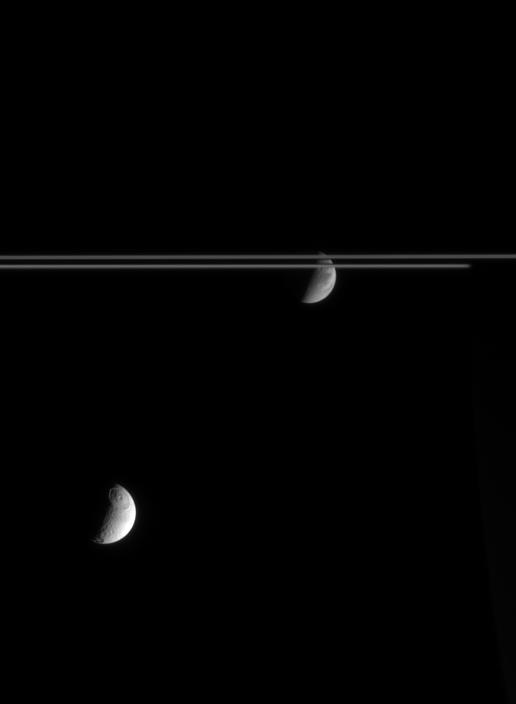Children of Saturn

| PIA Number | PIA07659 |
|---|---|
| Language |
|
With the icy rings between them, Dione and Tethys each show off the prominent features for which they are known. Dione, beyond the rings, displays wispy fractures that adorn its trailing side. Tethys, on the side of the rings closest to Cassini, shows its large impact basin Odysseus.
At right, the night side of Saturn can be seen occulting the far side of the rings. The view shows the Saturn-facing side of Dione (1,126 kilometers, or 700 miles across) and the anti-Saturn side of Tethys (1,071 kilometers, or 665 miles across).
The image was taken in visible light with the Cassini spacecraft narrow-angle camera on Nov. 8, 2005, at a distance of approximately 3.5 million kilometers (2.2 million miles) from Dione and 2.8 million kilometers (1.8 million miles) from Tethys. The image scale is 21 kilometers (13 miles) per pixel on Dione and 17 kilometers (11 miles) per pixel on Tethys.
The Cassini-Huygens mission is a cooperative project of NASA, the European Space Agency and the Italian Space Agency. The Jet Propulsion Laboratory, a division of the California Institute of Technology in Pasadena, manages the mission for NASA's Science Mission Directorate, Washington, D.C. The Cassini orbiter and its two onboard cameras were designed, developed and assembled at JPL. The imaging operations center is based at the Space Science Institute in Boulder, Colo.
For more information about the Cassini-Huygens mission visit http://saturn.jpl.nasa.gov . The Cassini imaging team homepage is at http://ciclops.org .
Credit: NASA/JPL/Space Science Institute
